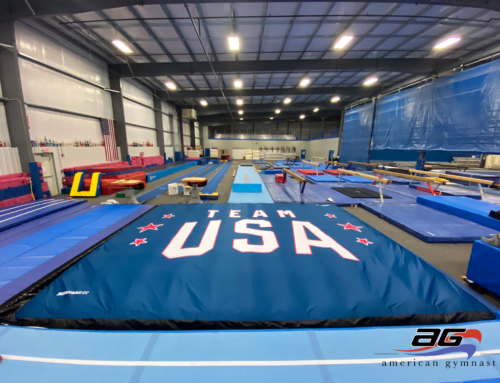It’s been a while since we’ve heard a lot of uplifting news from the Romanian women’s delegation.
After losing out on a world medal in 2010, the Romanian team appeared to be gaining momentum in 2011 with the return of its legendary successful coaches, Octavian Belu and Mariana Bitang, as well as 2004 Olympic star Catalina Ponor. Reigning Olympic floor champion Sandra Izbasa was also regaining her world class form and won gold on both floor and vault at the 2011 European Championships. It appeared that the team that dominated gymnastics for most of the 1990’s and early 2000’s was catching back up to the Americans, Russians, and Chinese, all of whom had outclassed them on the world stage over the last several years.
But a last-minute withdrawal from Izbasa at the 2011 worlds and continued low scores on the uneven bars caused the 2000 and 2004 Olympic team champions to again finish off the world medal podium – this time just 0.4 behind the Chinese. Izbasa’s big scores on floor and vault would have likely made up this difference, but it was a moot point. The Romanians didn’t bring home any individual world medals from Tokyo either, and it was clear this team still had a whole lot of work to do if it hoped to challenge for Olympic medals in London. Today’s demanding code of points – which favors big difficulty scores and punishes technical errors on uneven bars more harshly than ever before – just didn’t seem to be a good fit for the Romanians, whose safe, consistent gymnastics and often sketchy bar routines had been enough to win world and Olympic medals in years past.
Next, their biggest star, Ana Porgras – one of the best all-around gymnasts in the world as well as the 2010 world beam champion and 2009 world bars bronze medalist – retired suddenly in Janurary of this year, citing repeated injuries and burnout. As Porgras was the lone strong bar worker on a team that is struggling more than ever on this event, her retirement was a tremendous blow to the already dwindling Olympic medal chances for this Romanian squad.
A month later, Izbasa, who had recovered from the foot injury that kept her off the 2011 world team, suffered a knee injury that initially appeared to threaten her Olympic chances. Losing this world and Olympic medal contender for the second year in a row would have been yet another devastating hit to a team that was clearly running out of big guns to take to the main event in London.
A dual competition with France this weekend served notice that things might be finally turning around for this team. Larisa Iordache, a well-known junior sensation who has had an impressive senior debut this year, is officially Romania’s new star and is improving at lightning speed. Iordache, who placed 3rd at this year’s American Cup behind Americans Jordyn Wieber and Aly Raisman, has not only become this team’s best bar worker and a desperately needed replacement for Ana Porgras – she’s established herself as a legitimate Olympic all-around medal contender. She introduced an exciting and valuable double-double on floor at this competition, showed continued improvement on form and fluidity on bars, and posted a massive 60.15 all-around total – the highest of the competition and one that could challenge the world’s best at the Olympics this summer.
Sandra Izbasa also officially proved her knee injury in February was nothing serious, as she competed on all four events this weekend and posted a solid 56.6, including a 14.7 on vault (laid-out Podkopayeva) and 14.2 on floor (6.1 D-score). Izbasa still has room for improvement, but overall she demonstrated she is healthy and ready to help lead this team on an Olympic medal charge against the three nations that have stolen their world and Olympic glory since 2004.
Catalina Ponor competed on vault and beam, posting a 14.9 for a strong DTY and a huge 15.55 for a rock-solid beam set. She didn’t compete floor here, but her routine from the recent Doha World Cup won her a gold medal on that event, and it’s clear she’ll be in contention for one of Romania’s team finals spots on all three of these events in London.
The remaining team members – Diana Chelaru, Amelia Racea, Diana Bulimar, and Oana Haidu – were lacking in major highlights this weekend, with continued weak scores on uneven bars and 14’s at best on the other three events. Perhaps most noteworthy was Bulimar’s strong 14.9 on beam (6.0 D-score) and 14.4 on floor (5.8 D-score), as well as Haidu’s 14.0 on bars – the team’s only 14 besides Iordache on this event.
Below is a video linked by The Couch Gymnast of several routines from this competition. A few more notes will follow:
Selected Routines, 2012 Romania vs. France
Sandra Izbasa Vault 2012 Romania vs. France
Iordache has improved her form on bars. She was supposed to do a free-hip full turn out of the Shaposhinova, but she covered well. The stalder-half turn out of the Pak salto is also new. This routine scored a 14.6 – a GREAT score for Romania on this event.
Izbasa’s bars isn’t too bad. It scored a weak 13.15 out of a 5.5 D-score, but this was with a 0.2 deduction for having a C-dismount (double twist) rather than the required D. She can do a full twisting double back, and if she adds this back in it will add 0.3 to her total score. She’ll need to get this score up to at least a 14 to be valuable to Romania here. Could Izbasa be an all-around medal threat in London? Her bars will need to improve, but she will now likely be Romania’s second all-arounder behind Iordache. What a refreshing addition she’ll be to the Olympic all-around mix.
Youna Dufournet showed a new Jordyn Wieber-like opening sequence on bars. This wasn’t the best routine we’ve seen from Dufournet, but at least she is healthy. Her double layout was much improved – more stretched out than we’ve seen her do in the past.
Ponor’s DTY is strong, and I’ve wondered since last year if she’s capable of an Amanar. That would be HUGE for Romania, but time is running out. She and Iordache are likely the only two Romanians who are potentially capable of this 6.5 value vault.
Izbasa, on the other hand, is capable of at least a 6.1 vault, as we have seen from training videos. She recently showed a half-on, front layout with full turn off, and appeared to do it quite well. If she could land this well on a competition surface, it could be worth doing for Romania. They are quite far behind the U.S. on this event, and at least a little behind Russia as well.
I like Dufournet’s laid-out Podkopayeva because she waits before she completes the last half turn – you can actually seen quite a bit of front layout in there before she twists.
Ponor’s beam routine was stellar here, and she is looking more “fit” than ever. Last year she had an additional tumbling pass – a round-off to stretched layout – but it appears she has now straightened out the layout at the end of the Onodi-back handspring layout sequence, which last year was likely counted as piked. This is an important distinction, as the layout is worth an E element. This routine had a 6.3 D-score, and if she adds the full-in dismount back in, it will have a super 6.5. She’s a definite Olympic medal contender here.
Iordache is an absolute firecracker on floor. This is brand new music and choreography, and it works so well for her – one of the best Romanian dancers in years. Her double-double lifts her into a new class on this event and is huge for both her all-around chances and Romania’s team medal potential. She is one of the “lightest” gymnasts I have ever seen, in both the tumbling and in the dance. Her triple turn was actually spectacular – if she turns it into a quad she’ll gain two more tenths in difficulty (from 6.1 to 6.3). I’d say she’s now an Olympic medal contender on floor as well.
Romania’s team total here, counting three gymnasts per event, was a 175.2, which equates with an average of 14.6 across all four events. Although I know it’s a different competition, just for a reference, this score would have placed them third at least year’s worlds – ahead of the Chinese and just 0.129 behind the Russians.
Although Romania still has work to do on bars, I think they’re back in it – at least in the hunt for the Olympic team bronze medal. With Iordache’s upgrades, Izbasa’s return, and Ponor still looking world class, you’d have to think this team is AT LEAST as good as China, if not better. They are still a couple of bigger vaults and bigger bars scores away from challenging the U.S. and Russia, but this weekend’s competition had to have given them a great deal of confidence. Perhaps Iordache, Izbasa, and Ponor have some more tricks to reveal over the next couple of months, and perhaps this team can squeak out a couple more 14’s on bars. They may not be the front runners for gold in London, but rest assured, they don’t plan on leaving without any medals this time.



Leave A Comment